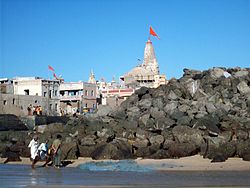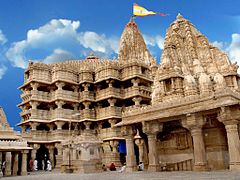Dwarka
| Dwarka દ્વારકા |
||
|---|---|---|
|
|
||
| State : |
|
|
| State : | Gujarat | |
| District : | Devbhumi Dwarka | |
| Sub-district : | Okhamandal | |
| Location : | 22 ° 15 ′ N , 68 ° 58 ′ E | |
| Height : | 7 m | |
| Area : | 42.1 km² | |
| Residents : | 38,873 (2011) | |
| Population density : | 923 inhabitants / km² | |
| Dwarka - Dwarkadheesh Temple | ||
Dwarka ( Gujarati દ્વારકા; also Dvaraka ) is a city on the Arabian Sea on the western tip of the Kathiawar peninsula in the Indian state of Gujarat . The city is located in the Devbhoomi Dwarka district , which was detached from the Jamnagar district on August 15, 2013 . Dwarka is one of the seven holy cities of Hinduism ; in Hindu religious texts, dwarka was the abode of the god Krishna .
Location and climate
The city of Dwarka is located at the mouth of the Gomti River , which is only about 20 km long, into the Arabian Sea, about 1325 km (driving distance) southwest of the Indian capital Delhi and about 440 km west of the city of Ahmedabad at a height of about 7 m . The climate is warm to hot; Rain (approx. 405 mm / year) almost only falls in the summer monsoon months .
population
| year | 1991 | 2001 | 2011 |
| Residents | 27,824 | 33,626 | 38,873 |
Approx. 85% of the population are Hindus , 14.5% are Muslims ; the rest is distributed among other religions ( Sikhs , Jains , Buddhists , Christians ). The proportion of the male population is approx. 10% higher than the female population, which - in addition to the abortion of female fetuses , which is more common in India - is also due to the main immigration of male workers.
economy
Inshore and deep sea fishing hardly play a role anymore. Many residents of the city live directly or indirectly from pilgrimage tourism, which is gradually turning into vacation tourism with western influences.
history
Dwarka (= "gate") was a fishing village and a city of trade with other cities on the Arabian Sea; the first traditional residents or rulers were the Yadava . Dwarka was later the capital of the Saurashtra region, which is largely identical to today's Kathiawar peninsula. According to the ancient Indian texts, after killing his demonic (half) uncle Kamsa , Krishna moved to Dwarka, where he ruled a kingdom. Already around 500 BC The Dwarkadish Temple is mentioned, but it was repeatedly damaged in the course of the Islamic advance and destroyed in 1473 by the troops of Mahmud Begada ; it was only gradually rebuilt in the 16th century.
Attractions
- The main attraction of the city is the Dvaraka Temple , which is one of the four pilgrimage temples on the Hindu pilgrimage route Char Dham . It was virtually rebuilt in the 16th century after previous destruction. It consists of a four-storey vestibule ( mandapa ) and a cella ( garbhagriha ) with a 76 m high Shikhara tower, at the top of which a flag flies. Here the deity Dwarkadeesh is worshiped, a modification of Vishnu's Vamana incarnation Trivikrama .
- Before the believers enter the temple, they can cleanse themselves of their sins at the Gomti Ghats . There are numerous shrines in honor of the Indian gods.
- Surroundings
- The Rukmini Devi Temple, built in the 12th century, is about 2 km north of the city. The whitewashed dome over the vestibule (mandapa) is more recent.
- There are numerous inconspicuous temples in the coastal towns to the north and south of the city, but they are very old (7th-9th centuries).
- One of the 12 Jyotirlinga shrines in India is located in Nageshwar, approx. 16 km northeast of Dwarka .
- About 35 km north is the 11 km² island of Bet Dwarka with numerous temples and beaches.
literature
- SR Rao , The Lost City of Dvaraka , National Institute of Oceanography, 1999, ISBN 81-86471-48-0
- SR Rao, Marine Archeology in India, Delhi, Publications Division, 2001, ISBN 81-230-0785-X
Web links
- Dwarka, Gomti Ghat - Photos and brief information (English)
- Dwarka, Underwater Archeology - Info
- Dwarka, Jagad Mandir - Photos + Info (English)



